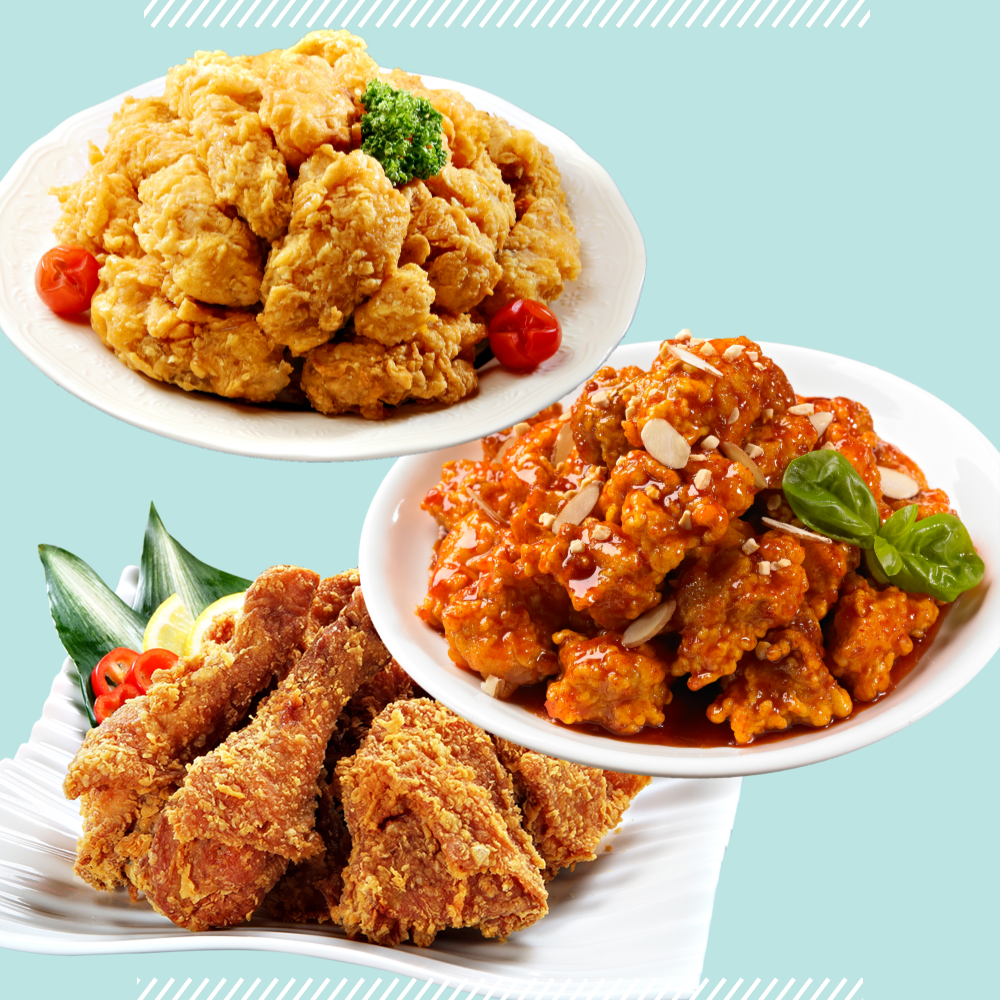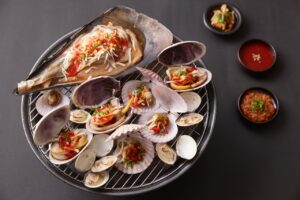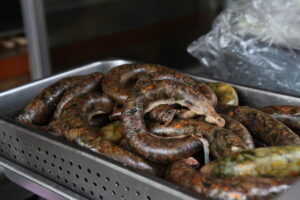
Korean Style Fried chicken

Korean Fried Chicken Style.
Korean Fried Chicken (KFC) is a style of fried chicken that is known for its distinct characteristics, flavors, and preparation methods compared to other fried chicken styles. Here are some key differences that set Korean Fried Chicken apart:
- Double-Frying Technique:
One of the most notable differences in Korean Fried Chicken is the double-frying technique. The chicken is first fried at a lower temperature to cook the meat through, and then it’s fried at a higher temperature to achieve a crispy and golden exterior. This results in a unique combination of tender and juicy meat with an exceptionally crispy outer layer. - Thin and Crispy Coating:
Korean Fried Chicken features a thin and delicate coating that becomes incredibly crispy due to the double-frying process. The coating is often made using a mixture of wheat flour, cornstarch, and sometimes rice flour, which contributes to its crunchiness. - Variety of Flavors:
KFC is known for offering a wide variety of flavors and sauces. Popular choices include original (with a light seasoning), sweet and spicy, soy garlic, honey butter, and more. The range of flavors allows for diverse taste experiences, catering to different preferences. - Sauces and Glazes:
Korean Fried Chicken is often coated with flavorful sauces or glazes after frying. These sauces can range from spicy and tangy to sweet and savory. The sauces enhance the overall flavor and provide a delicious coating that complements the crispy chicken. - Diverse Cuts and Styles:
In addition to the classic bone-in chicken pieces, Korean Fried Chicken may also include boneless options, chicken tenders, or even whole chicken. This diversity of cuts and styles offers flexibility for consumers to choose their preferred way of enjoying the dish. - Side Dishes and Accompaniments:
Korean Fried Chicken is often served with various side dishes and accompaniments, such as pickled radishes, coleslaw, and pickles. These sides provide a balance of flavors and textures alongside the crispy chicken. - Social and Cultural Significance:
Korean Fried Chicken is not only about the flavors; it’s also deeply connected to social gatherings and moments of enjoyment. It’s commonly enjoyed in group settings, often accompanied by beer (chimac) and shared among friends or family. - Worldwide Popularity:
The popularity of Korean Fried Chicken has extended beyond Korea’s borders. Korean-style fried chicken restaurants have become popular in various countries, introducing people around the world to the unique flavors and textures of KFC.
In summary, Korean Fried Chicken stands out due to its double-frying technique, thin and crispy coating, diverse flavors, and social significance. It’s a dish that combines indulgence with innovation, offering a memorable culinary experience that continues to capture the hearts (and taste buds) of many.
Let’s go Chimac(치맥?)
“Chimac” is a fusion food concept that combines “chicken” and “beer.” It refers to the popular practice of pairing fried chicken with beer, creating a satisfying and indulgent combination. Chimac has become a beloved culinary trend in South Korea and is also enjoyed in other parts of the world, particularly among those who appreciate the combination of crispy fried chicken and a cold beer.
Origin and Evolution: The concept of chimac has its roots in South Korea, where fried chicken and beer are both widely enjoyed. The practice of enjoying fried chicken with beer gained popularity, especially in social settings such as gatherings with friends, celebrations, and evenings out. Over time, the term “chimac” was coined to encapsulate this pairing of flavors.
Popularity and Culture: Chimac has become more than just a culinary combination; it’s a cultural phenomenon. Many restaurants and establishments in South Korea specialize in serving various styles of fried chicken, often offering a variety of flavors, coatings, and dipping sauces. The beer is typically served cold and complements the savory and sometimes spicy flavors of the fried chicken.
Variations and Accompaniments: Chimac offerings can vary widely. Fried chicken may come in different flavors such as sweet and spicy, garlic, soy garlic, and more. Additionally, side dishes like coleslaw, pickles, and sauces are often served alongside the chicken and beer to enhance the overall dining experience.
Global Spread: The popularity of chimac has extended beyond South Korea’s borders. Korean-style fried chicken and the chimac concept have gained traction in other countries, leading to the establishment of Korean fried chicken restaurants around the world. The crispy, flavorful nature of Korean fried chicken, along with the idea of pairing it with beer, has resonated with diverse audiences.
Social Experience: Chimac is not just about the flavors; it’s also about the social experience. Gathering with friends or family, enjoying good food, and having conversations over chicken and beer contribute to the enjoyment of chimac.
Cultural Impact: Chimac has had a significant impact on the culinary scene and social culture in South Korea. It’s a trend that’s here to stay, with new variations and innovations emerging to cater to changing tastes and preferences.
In summary, chimac is a modern culinary trend that captures the enjoyment of pairing crispy fried chicken with a cold beer. Its popularity is a testament to the appeal of combining indulgent flavors and the communal joy of sharing a meal with others.
Cooking Method
Making Korean-style fried chicken, also known as “Yangnyeom Chicken,” involves a two-step frying process to achieve a crispy and delicious result. The chicken is first fried at a lower temperature to cook through, and then it’s fried again at a higher temperature to get that extra crispy outer layer. Here’s a basic recipe to make Korean-style fried chicken:
Ingredients:
For the chicken:
- 2 pounds (about 1 kg) chicken wings or drumsticks
- 1 cup all-purpose flour
- 1 cup cornstarch
- 1 teaspoon baking powder
- 1 teaspoon salt
- 1/2 teaspoon black pepper
- 1 cup cold water
For the sauce:
- 1/4 cup gochujang (Korean red pepper paste)
- 1/4 cup ketchup
- 2 tablespoons soy sauce
- 2 tablespoons honey or brown sugar
- 1 tablespoon rice vinegar or apple cider vinegar
- 3 cloves garlic, minced
- 1 tablespoon grated ginger
- 1 tablespoon sesame oil
For garnish (optional):
- Toasted sesame seeds
- Sliced green onions
Instructions:
- In a large mixing bowl, combine the all-purpose flour, cornstarch, baking powder, salt, and black pepper. Mix well.
- Gradually add the cold water to the dry mixture while stirring continuously until you get a smooth batter. The batter should be thick enough to coat the chicken pieces.
- Add the chicken wings or drumsticks to the batter and toss them until they are evenly coated. Let the chicken sit in the batter for about 10 minutes to absorb the flavors.
- While the chicken is resting, prepare the sauce. In a separate bowl, mix together the gochujang, ketchup, soy sauce, honey (or brown sugar), rice vinegar (or apple cider vinegar), minced garlic, grated ginger, and sesame oil. Adjust the sweetness and spiciness according to your taste preference.
- In a deep fryer or a large heavy-bottomed pot, heat vegetable oil to around 350°F (175°C) for the first round of frying.
- Fry the chicken pieces in batches for about 8-10 minutes or until they are cooked through and have a light golden color. Remove them from the oil and let them drain on a paper towel.
- Increase the oil temperature to 375°F (190°C) for the second round of frying.
- Fry the chicken pieces again in batches for about 5-7 minutes or until they become crispy and golden brown. Be careful not to overcrowd the pot during this step.
- Once the chicken is fully cooked and crispy, remove it from the oil and let it drain on a paper towel.
- In a large mixing bowl, toss the fried chicken pieces with the prepared sauce until they are evenly coated.
- Garnish with toasted sesame seeds and sliced green onions if desired.
- Serve the Korean-style fried chicken hot and enjoy!
Place for Fried Chicken in Seoul >> Kkanbu Chicken Jongno District 81, Sambong-ro, Jongno-gu, Seoul 03150 South Korea

Recommend to Read >> Makgeolli, the Harmony of Korean Food and Liquor – 2023





